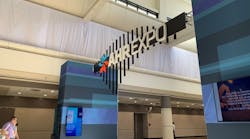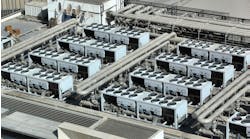Although facts and figures continue to fluctuate in the HVACR industry, one thing remains consistent: The climate crisis drives the industry’s current trends. At the AHR Expo 2020, experts in sessions and on the show floor discuss what they’re seeing in the field today from the impact of the climate crisis, including major moves toward decarbonization and a stronger focus on indoor air quality.
Below are three trends worth noting.
1. Moving toward decarbonization
HVACR companies across the board are implementing and improving on ways to move toward decarbonization or reduce their carbon usage. In the commercial sector, heat pumps are a major device helping buildings decarbonize their heating and cooling processes.
(Photo: A. O. Smith's 120-gallon commercial heat pump; Credit: A. O. Smith.)
“It’s still on an early leg, but the interest in commercial heat pumps isn’t going away,” Schulz says. “We’ve lived through solar water heaters and some other things that have come and gone—but we don’t think [heat pumps] are going anywhere.”
2. More IoT-enabled/automation products
On the expo floor, many companies and manufacturers, including Siemens and Mitsubishi Electric, displayed integrated building automation products. One of the major drivers behind automation is having the ability to constantly and automatically monitor a building’s systems and assets—from HVACR to access controls to fire protection.
[Related: How IoT Devices Enable Predictive Maintenance]
With IoT-enabled systems, there’s also opportunities for facilities managers and building owners to better understand how their building is used, so it can ultimately run more efficiently.
“Our wireless, intelligent equipment and technology gives building owners and operators access to useful information and making sure everything’s operating as it should be—if it’s not, then what’s wrong?” says Mike Schwartz, CEO of Daikin Applied Americas. “They can tell by looking at their smartphone. Connectivity is where we’re putting a lot of focus.”Photo: Siemens' new Building Operator cloud-based building management application; Credit: Siemens
3. An increase in VRF implementation
The U.S. has seen double digit growth in the implementation of variable refrigerant flow (VRF) HVAC systems, says Saziye Dickson, global research manager of AC, ventilation and refrigeration for BSRIA, a U.K.-based research and consultancy organization. “America is really embracing VRF technology,” she adds.
Unlike conventional HVAC systems, VRF sends varied volumes of refrigerant to evaporators that control different spaces, meeting the needs and setpoints in each space. These systems are ideal for buildings with varied heating and cool loads, such as large office spaces, or buildings that are pursuing LEED certification.
Mike Smith, senior marketing manager at Mitsubishi Electric, says VRF in the U.S. has reached a “tipping point.” He adds, “It’s really catching on—the market demand is driving adoption.”
Time of Change
From continually improving technology to the seriousness of the climate crisis, the HVACR industry is in the midst of a major transformation.
“It’s a time of tremendous change in the industry right now,” says Schwartz. “I’ve been in the industry a long time, and I’ve never seen the magnitude of change that we’re in at this time. But this creates a lot of opportunity for manufacturers like us and a higher bar and challenge to be at the front end of what’s going on.”
Read Next: Energy Saving VRF Systems Worth Money



